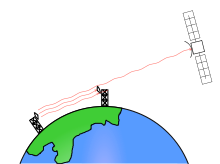Aquacade (satellite)
The Aquacade satellites ( dt. Water ballet ) (formerly Rhyolites ) were a series of telecommunications spy satellites in the USA in the 1970s. They were run by the NGO for the CIA . The NSA was also reportedly involved.
history
The program, also known as AFP-720 and AFP-472, is still classified as confidential. At the same time, the Canyon satellites were in operation with a slightly different technical focus. The program's original name Rhyolite was changed to Aquacade in 1975 following the disclosure of the name in the Christopher Boyce and Andrew Lee trial . The Aquacade system was replaced by the Magnum from 1985 and by the Orion / Mentor satellites from 1995 .
construction
The Rhyolite / Aquacade satellites were manufactured by TRW . They had receiving antennas with a diameter of over 10 meters.
How it works and uses
The main purpose of the Rhyolite satellites was stated to be the interception of Soviet and Chinese radio relay signals . During the 1960s and 1970s, much of the long-haul telephone and data connections were carried over terrestrial radio links. Each station consists of a parabolic antenna on a radio tower that sends a narrow signal lobe to a receiving station in the area. A considerable part of the radio waves miss the receiving antenna and radiate out into space due to the curvature of the earth. By placing a satellite in a convenient location in geosynchronous orbit , the US government was able to eavesdrop on Soviet telephone calls and telex transmissions during the Cold War . Allegedly, as early as 1970, these satellites were able to record almost 11,000 telephone calls simultaneously, which, however, far exceeded the capacity for analysis.
Satellites
It is believed that at least four Rhyolite / Aquacade satellites were launched between June 1970 and April 1978. All launches were from the LC-13 launch complex on Cape Canaveral using Atlas SLV-3A / Agena D launch vehicles . The payload fairings were extended, presumably to accommodate the satellite's large parabolic antenna.
The satellites had a mass of around 700 kg and were positioned over the Middle East or Indonesia . The signals were transmitted to the Pine Gap receiving station in Australia and from there, encrypted, via another satellite to Fort Meade in the USA for analysis.
| designation | Start ( UTC ) | COSPAR name | NORAD ID |
|---|---|---|---|
| OPS 5346 / AFP-720 Rhyolite 1 | June 19, 1970, 11:37 am | 1970-046A | 04418 |
| OPS 6063 / AFP-720 Rhyolite 2 | March 6, 1973, 9:30 am | 1973-013A | 06380 |
| OPS 4258 / AFP-472 Aquacade 3 | December 11, 1977, 10:45 p.m. | 1977-114A | 10508 |
| OPS 8790 / AFP-472 Aquacade 4 | April 7, 1978, 12:45 am | 1978-038A | 10787 |
literature
- Richelson, Jeffrey T. ed. US Military Uses of Space, 1945-1991 Vol 1, Guide. National Security Archive. 1991.
Individual evidence
- ↑ a b James Bamford: The Shadow Factory. Doubleday, 2008, ISBN 0-385-52132-4 , p. 176.
- ↑ Jonathan McDowell: Jonathan's Space Report No. 509 September 18, 2003, accessed July 17, 2014 .
- ↑ SIGINT Overview. Federation of American Scientists, March 9, 1997, accessed on July 17, 2014 (English): “The first generation of these satellites, known as Rhyolite, were launched in the early 1970s, and had a receiving antenna with a diameter of over ten meters. "
- ↑ Michael Simm: Battle can be followed on screen. February 20, 1991, accessed on April 5, 2020 (originally published in “DIE WELT” on February 20, 1991).
- ↑ Rhyolite in the Encyclopedia Astronautica , accessed on July 17, 2014 (English).
